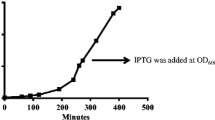Abstract
A novel ‘pipeline’ system for the preparation of therapeutic monoclonal antibodies (mAb) in a non-GMP compliant environment has been developed. We used sterile silica-gel pipes to connect individual process units, in order to form a fully-enclosed and seamlessly connected system. This ‘pipeline’ system was used to implement downstream preparation processes for a humanized anti-CD146 mAb, huAA98, which is a therapeutic mAb generated to inhibit cancer-related angiogenesis. The quality assessment of the huAA98 end-product indicated that endotoxin levels were 0.016 EU/ml, protein A levels were 1.08 ng/ml and host cell protein (HCP) was undetectable. Thus, all measures were below the clinical criteria set by the Chinese Pharmacopoeia (Edition 2010). Having passed our proof-of-concept test, this ‘pipeline’ system can be used as a universal platform for the preparation of mAbs suitable for pre-clinical studies, in a non-GMP compliant laboratory environment.






Similar content being viewed by others
References
Gottschalk U (2008) Bioseparation in antibody manufacturing: the good, the bad and the ugly. Biotechnol Prog 24(3):496–503
Horenstein AL, Crivellin F, Funaro A, Said M, Malavasi F (2003) Design and scaleup of downstream processing of monoclonal antibodies for cancer therapy: from research to clinical proof of principle. J Immunol Meth 275(1–2):99–112
Li J, Zhu Z (2010) Research and development of next generation of antibody-based therapeutics. Acta Pharmacol Sinica 31(9):1198–1207
Munro TP, Mahler SM, Huang EP, Chin DY, Gray PP (2011) Bridging the gap: facilities and technologies for development of early stage therapeutic mAb candidates. mAbs 3(5):440–452
Reichert JM (2012) Marketed therapeutic antibodies compendium. mAbs 4(3):413–415
Wang Z, Yan X (2013) CD146, a multi-functional molecule beyond adhesion. Cancer Lett 330(2):150–162
Yan X, Lin Y, Yang D, Shen Y, Yuan M, Zhang Z, Li P, Xia H, Li L, Luo D, Liu Q, Mann K, Bader BL (2003) A novel anti-CD146 monoclonal antibody, AA98, inhibits angiogenesis and tumor growth. Blood 102(1):184–191
Zhang Y, Zheng C, Zhang J, Yang D, Feng J, Lu D, Yan X (2008) Generation and characterization of a panel of monoclonal antibodies against distinct epitopes of human CD146. Hybridoma 27(5):345–352
Zheng C, Qiu Y, Zeng Q, Zhang Y, Lu D, Yang D, Feng J, Yan X (2009) Endothelial CD146 is required for in vitro tumor-induced angiogenesis: the role of a disulfide bond in signaling and dimerization. Intern J Biochem Cell Biol 41(11):2163–2172
Acknowledgments
This study is partly supported by the National High-tech R&D Program of China (863 program) (2012AA02A304), the National Science and Technology Major Project (2013ZX10002-009-014, 2013ZX10004102).
Author information
Authors and Affiliations
Corresponding author
Rights and permissions
About this article
Cite this article
Wang, F., Yan, X., Song, L. et al. A novel ‘pipeline’ system for downstream preparation of therapeutic monoclonal antibodies. Biotechnol Lett 35, 1411–1418 (2013). https://doi.org/10.1007/s10529-013-1234-2
Received:
Accepted:
Published:
Issue Date:
DOI: https://doi.org/10.1007/s10529-013-1234-2




